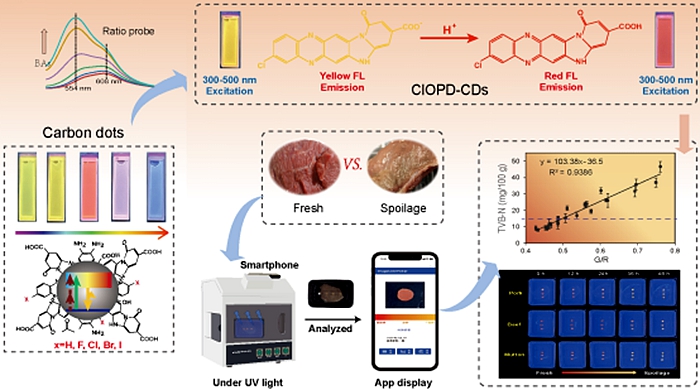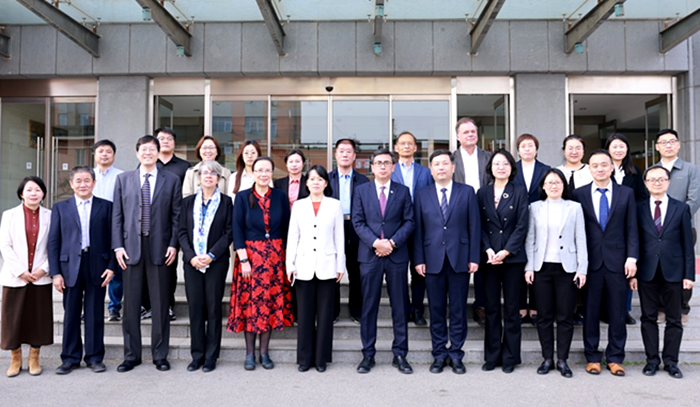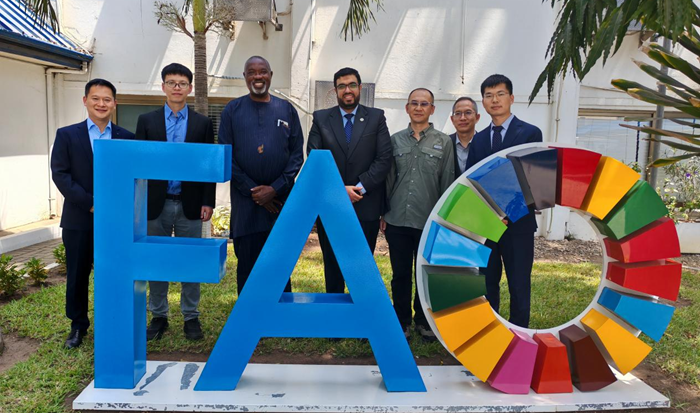An advanced intelligent freshness detection technology for meat products using halogen-functionalized fluorescent carbon dots
Recently, researchers from Meat Science and Nutrition Innovation Team, Institute of Food Science and Technology, Chinese Academy of Agricultural Sciences (IFST-CAAS), successfully developed an advanced intelligent freshness detection technology for meat products using halogen-functionalized fluorescent carbon dots. The research result was published in Nano Today (JCR 1, IF: 13.2). Dr. Minghui Gu, PhD student, was the first author, Prof. Dequan Zhang served as the corresponding author. This study was financially supported by the Key R&D Program of Shandong Province, China (2023CXGC010708), and National Key R&D Program of China (2022YFD2100500).
Fresh meat, rich in moisture and nutrients, is susceptible to spoilage during storage and transportation, leading to substantial resource wastage and economic loss annually. To mitigate this problem, the team targeted biogenic amines, such as putrescine and cadaverine, which are characteristic of meat spoilage, as detection targets. They introduced an innovative halogen doping strategy, addressing the industry's traditional detection challenges of dependence on lab equipment, time-consumption, and high costs.
The study employed a halogen doping strategy with chlorine and bromine, using o-phenylenediamine and citric acid as precursors, to synthesize multicolor fluorescent carbon dots via a one-pot method. It was found that halogens significantly reduce the material's energy gap by modifying the electronic structure of ligand aromatic rings, leading to fluorescence red-shift. When exposed to spoilage-induced biogenic amines, the fluorescence color of chlorine-doped carbon dots (ClOPD-CDs) changes from orange-red to bright yellow (color difference ΔE = 44.66, perceivable by the naked eye). Sensitivity is several times higher than that of traditional fluorescence probes, and full visible spectrum coverage from 400 to 650 nm was achieved. Consequently, the research team developed a smartphone detection app enabling users to attach a fluorescent sensing tag inside packaging, avoiding direct contact with the meat. The total volatile basic nitrogen (TVB-N) content detection is completed within three minutes, achieving an accuracy of R² = 0.9386. Laboratory application verification for spoilage warnings has been accomplished for pork, beef, and mutton.
These findings not only introduce a new paradigm for meat freshness detection but also suggest that the proposed halogen-functionalized carbon dot technology can be extended to the rapid detection of other perishable foods, such as seafood and dairy products, providing a foundational framework for technological innovation in food safety.
Source: https://doi.org/10.1016/j.nantod.2025.102675

Fig.1 Applications of halogen-functionalized carbon dots in food freshness detection.
-
 Apr 11, 2025Strengthening China-Mongolia Grassland Cooperation to Build a Cross-Border Green Ecological Barrier
Apr 11, 2025Strengthening China-Mongolia Grassland Cooperation to Build a Cross-Border Green Ecological Barrier -
 Apr 03, 2025CAAS and CABI Forge a New Chapter in Strategic Cooperation
Apr 03, 2025CAAS and CABI Forge a New Chapter in Strategic Cooperation -
 Mar 21, 2025Experts from IPPCAAS Implement FAO-China South-South Cooperation Project to Advance Sustainable Fall Armyworm Management in Ghana
Mar 21, 2025Experts from IPPCAAS Implement FAO-China South-South Cooperation Project to Advance Sustainable Fall Armyworm Management in Ghana -
 Mar 13, 2025CAAS and CGIAR Deepen Strategic Cooperation
Mar 13, 2025CAAS and CGIAR Deepen Strategic Cooperation -
 Mar 11, 2025Call for Logo Design Proposals for the China-Africa Agricultural Science and Technology Innovation Alliance (CAASTIA)
Mar 11, 2025Call for Logo Design Proposals for the China-Africa Agricultural Science and Technology Innovation Alliance (CAASTIA)
